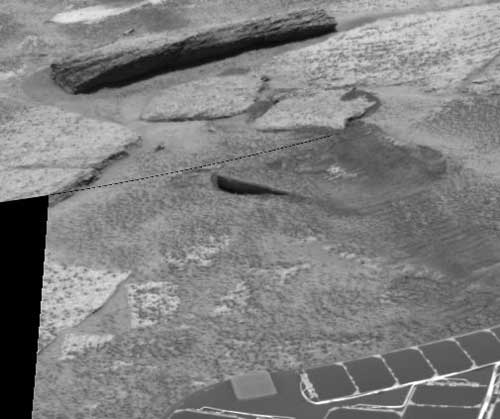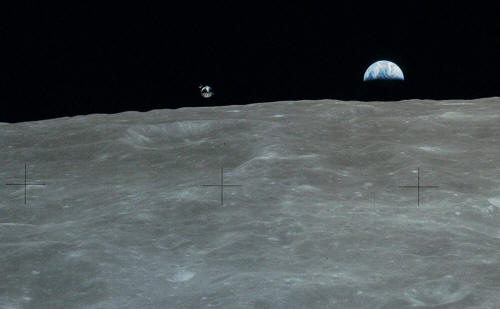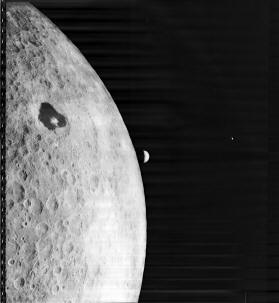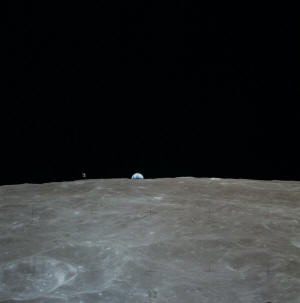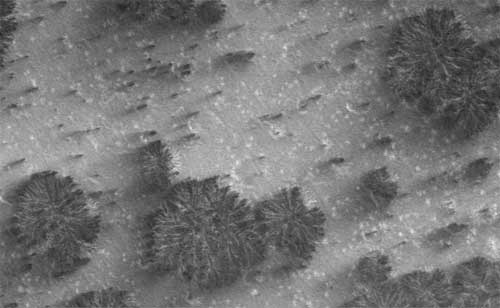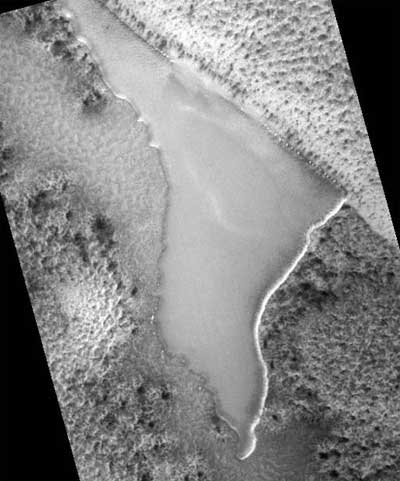|
August 5, 2008 from TheCrit Website
There are vast forests on Mars, ones that are kept from the public. This piece of wood looks like it floated to its present location, being partially sunk in the soil. The ground around it is very interesting. Notice the flat rock formation of the soil and the crevices in between them.
Does this look familiar?
It appears to be the bed of a dried up pond. There had to be a significant amount of water in this area, water high enough to lift that railroad tie sized piece of timber and float is perhaps several miles. The Mars Reconnaissance Orbiter showed that vast regions of the Red Planet have been altered by floods.
This dried pond effect should come as no surprise.
This flood had to have happened within the past thirty or forty years because the wood is intact, though this is judging the rate of decay by Earth standards.
Some may say that Mars did have water on
it long ago and that it even had an atmosphere, which is true, but a
piece of timber isn’t going to survive for thousands of years.
These trees appear to be much larger than Earth trees, having a leaf and branch system that is unique to Mars. The foliage spans much wider than a similar plants on Earth do, rising to who knows what heights. The spacing between them could be the result of the dying Martian atmosphere. Dense forests more than likely filled large areas of Mars back in the days when it had a breathable environment.
There were undoubtedly several species
of trees, and different varieties of underbrush, which are now
extinct.
Mars has an ancient world that was destroyed, one with a face and a pyramid.
So it isn’t so hard to believe that the
moon did as well.
They claim that the moon was not mentioned in the Biblical story of
creation, but it was. The moon was referred to as “the lesser light
that rules the night” in Genesis 1:16. The moon stopped in the sky
in Joshua 10:30 but this had nothing to do with the alien presence
there.
Stop and ask yourself one question, if the moon really is as NASA claims that it is, then why are some photos classified and unavailable to the public while others are inked and blurred? One of the most famous examples of this is the Apollo 16 “Earth rise” photo (above images) in which “the Earth” is rising over the moon.
NASA says that the object in the picture is the Earth and few people question it. If you think for yourself, and look with an open mind, you will clearly see that this is a UFO.
This is another craft off to the left, which NASA doesn’t even attempt to explain away.
The fact that trees can survive in such an atmosphere, and with much less water than Earth trees do, reveals their unique structure while offering hope for an increasingly polluted Earth.
Since the Martian atmosphere is 95% carbon dioxide, these plants would have to thrive on it in a way much superior to Earth trees. They may give off oxygen, though I am using terrestrial vegetation for comparison, but they could give off another gas, one even toxic to humans. Seeding or drafting these trees in bulk could bring breathable air back to the Red Planet.
If Mars was so altered by water, then where did all that water go? Some of it went into the soil, much of it is frozen at the poles, and a good percentage of it went into a lake. NASA didn’t need to spend all that money on the Phoenix Mission in order to search for water on Mars.
All they had to do was look at their old
photographs.
Based on the findings of the Mars Reconnaissance Orbiter, that piece of wood could’ve floated for some distance before coming to its final resting place.
The lake, although frozen, Mars having a mean surface temperature of -46 degrees C, must contain more than just water.
There has to be some amebas and other single celled organisms in these waters. There are most likely fossils of Martian fish and perhaps even Martian animals. On Earth, old lake beds are a prime location in which to find dinosaur fossils.
Why would Mars be any different?
It’s time for NASA to come clean with
the public. It’s time that they land one of those rovers in
Cydonia, the Inca city, or in one
of forests.
|


